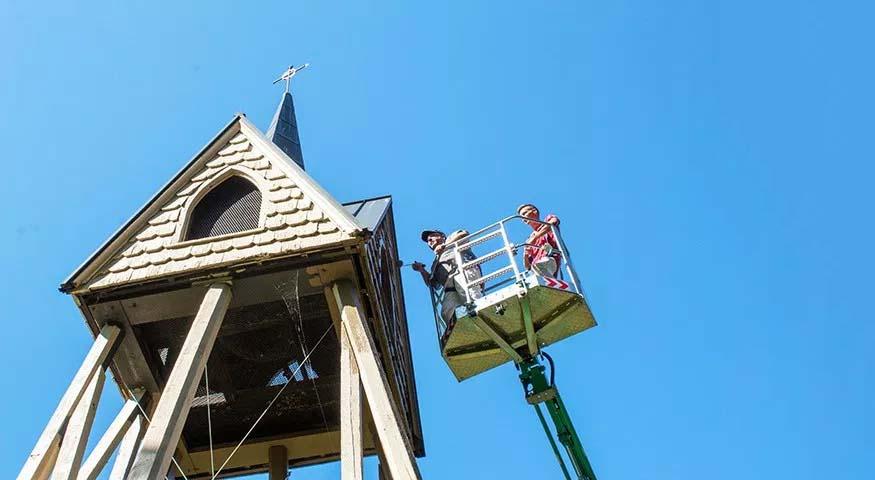
Bock-style bell tower gets a makeover
As a part of the college’s campus beautification campaign, the venerable bell tower is getting some maintenance and a new paint job.
Since 1936, the bell tower or klockstapeln, has stood at the base of Zion Hill, between Ascension Chapel and Old Main. The bell tower has been an iconic symbol and a focal point for college lore; many marriage proposals and wedding photos often take place beneath the tower.
It is an image that is instantly recognizable to alumni, staff and friends.

For a college with such a strong connection to Sweden, it is noteworthy that the bell tower may be the only structure that can truly be said to be a Swedish architectural design. The college’s historic buildings otherwise bear general influence from European and Midwestern American styles.
The bell originally hung in a belfry on top of the First College Building, built in 1875, when the college relocated from Paxton, Ill., to Rock Island. The 731-pound bell was cast by the foundry Vanduzen and Taft of Cincinnati, and was purchased by the college for $282.51.
By 1935, the First College Building became obsolete, having been replaced by Old Main in 1888 and subsequently serving as a men’s dormitory. With its demolition in 1935, plans were made to create a new home for the bell.
Other building materials were also salvaged from the First College Building, and a design for the new tower was drafted by architects Philip Peterson and Carl J. Peterson. The tower was completed between November 1935 and January 1936 and cost $200. In 1961, the tower received substantial restoration work.
One of the architects, Philip Peterson, attended First Lutheran Church in Rock Island. The Swenson Center’s Jill Seaholm, who also attends First Lutheran, grew up with Peterson’s grandson, Tim Anderson ’76, and recalls that Peterson “was good friends with my morfar, and Tim's mom and my mom grew up together. Philip was from Ånimskog parish in Älvsborg county. Tim says that his grandpa worked through the design with Dr. Bergendoff's approval and built it.”
Thomas Tredway, president emeritus, recalls that his predecessor, Conrad Bergendoff, “referred often to the Bell Tower in his chapel talks, fond of it as he was in the way it represented the roots of the college in the Church of Sweden. For him it was both a cultural and a religious icon.”
Scandinavian bell towers
The location of the bell tower, at the base of Zion Hill and near Ascension Chapel, was a logical choice. The chapel had been completed in 1923 as part of the seminary complex, and locating the bell by the chapel was a nod to ecclesiastical traditions in Sweden. Parish churches across the country often have a free-standing bell tower, called a klockstapel in Swedish.
Some of the inspiration for Scandinavian bell towers came from Southern Europe, such as the Italian campanile, however these are usually made out of brick or stone. In medieval Sweden, the medium and method available was a timberframe, stave construction. These free-standing towers are typically dark brown, weathered wood, or are painted with a rust-colored red, Falun Red.
While the earliest medieval churches would have smaller bells on their roofs, the bells increased in size over the years, and later churches needed free-standing towers that could handle this massive weight. A royal ordinance in the 1700s finally mandated that bells be hung in church steeples, yet many parishes retained their free-standing bell towers, too, often situated among the graves in the churchyard, or on a prominent ridge.
Dr. Kimberly La Palm, Augustana Swedish professor, notes that, “There is great community pride in these bells, as they often can be older than the church itself.”
One of the more famous bell towers in Sweden stands by the castle in the city of Uppsala, the home of Uppsala University and the ecclesiastical center of the Church of Sweden. Augustana has long had deep connections to Uppsala, and continues to send exchange students there.
Inside Uppsala’s bell tower hangs the massive “Gunilla Bell” which was cast in 1588 and donated by Queen Gunilla. This bell historically served as a vårdklocka, ringing each morning and evening, yet in modern times the bell has also become part of the student celebrations for Valborg Eve, the last day of April and the symbolic start of spring.
Goat legs
The Augustana bell tower’s four steep gables form a cross at the ridgeline, and its scalloped-shingle siding hearkens back to the stave churches found across Norway and Sweden. These churches drew inspiration from earlier Viking craftsmanship and design.
Augustana’s tower is an “open” tower, meaning that the support beams are exposed, rather than wrapped in siding. These open towers are referred to as galge (gallows) or bock (goat) style, the latter because they resemble the legs of a goat. Augustana’s klockstapel is a variant of this bock-style. An additional flourish is the Gothic arch in the belfry, an echo of the arches in the seminary complex and Ascension Chapel.
According to campus folklore, “If a couple kisses underneath the Augustana Bell Tower, they will stay together forever.”
— Dr. Mark Safstrom, assistant professor of Scandinavian Studies
